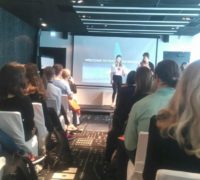FuckUp Morning Stockholm III – 17th May, 8am – 9am
The naming of the event certainly brings questions to one’s mind on what exactly it has to do with Startups. It led me to ignore the suggestion by FaceBook to attend the event 3 times before giving it a look. I certainly did not regret attending the event and here’s why.
The event was a short one hour introduction followed by a Q&A for each of the 3 speakers before it was time for the audience to commute to their work or universities.
First speaker – Andreas Vural, Founder and President of Happy Plugs.
Andreas Vural grew up in the small town Sveg, and moved to Stockholm to chase his entrepreneurial dream of making a mark in the world of fashion. In the city he moved through roles as an Art Director, to create the biggest social network (Pre-Facebook) in Sweden as well as running his own charity company. Andreas soon found the path to combine his biggest passions: fashion, design and music as he realised that there was a gap in the earphone market and his company Happy Plugs was born. Today, Happy Plugs is available at 6,000+ retailers in over 70 countries worldwide.
The Fuckup: His initial batch of 50000 earphones sold in Sweden fell apart in winter.
It was a disaster for him as the first few customers and products sold are the first impression customers have of the company, and Happy Plugs did not get off to a great start.
However, he managed to get over it and Happy Plugs now sells one headphone every minute.

Andreas and his quote – “Try and fail, but never fail to try”
Second speaker – Emilia de poret – singer, author and entrepreneur
Emilia de Poret is a true multi-talent including being a singer (she has been the open act for Katy Perry), TV-presenter, music production company owner, author, blogger, pod-caster and entrepreneur. Emilia grew up in an entrepreneurial family, which has inspired her to work hard and follow her passions. She strongly believes in constantly moving forward and always challenge herself to develop believing that “the worse thing that can happen is that you fail and that failure will make you stronger”.
The Fuckup: She was dropped abruptly from her record label company, and her dream job of being a singer were dashed.
For me, her story seemed to be the most inspiring one, as she managed to turn her life around following her failed attempt to become a singer, and in a big way too.
After knowing that she as dropped, she fell into a 2 week long depression, where according to her she did nothing but “eat ice-cream all day”. Thereafter, what got her out of the depression and starting moving again was a strong conviction that she was capable of turning her life around, being a young and healthy. She decided to become an entrepreneur. What really struck me was her ability to change her mindset to view her situation as one that
From then on, it was a success story for her until she started having doubts that she could balance both her kids and work. However, she managed to do it and realised that having kids made her life even better and thought her the importance of saying no as she started becoming more focussed as well.
She ended off her speech with 2 nuggets of wisdom:
- To always find a partner in business, as it is always easier to have someone to share the ups and downs with you on the tough entrepreneurial journey.
- Having a good posture improves ones confidence and look.
Q&A with Emilia
The Third Speaker – Peder Dinkelspiel, Founder and CEO at FoodFriends
Peder Dinkelspiel is a full speed Gyro Gearloose web entrepreneur with a million ideas. He has been involved in a number of digital startups and during the earlier days of Internet he co-founded the leading high-end social network SmallWorld. Peder later moved on to create the premium restaurant booking software WaiterAid and the tennis booking system MyCourt. He believes, that a network dedicated for people within the hospitality business is a great idea and holds the dream of digitizing the restaurant industry- even at times when few agree.
The Fuckup: While working at Nordnet, one of his earlier startups, he realised that the accounts of his users got hacked and their passwords got changed. They did not think of backing up their data at that time as well.
Peder seemed to be the most experienced of the three, having founded and worked at the most startups. What I was impressed by, was his habit of looking out for opportunities and ideas for a new startup in his daily life. For example, he came out with an idea of an app to manage “whose turn it is to drive” in a family while sending his kids to Tennis recently.
Also, he had an interesting management style where he steered away from micromanagement and instead made it his philosophy to to turn his managers into entrepreneurs, where he empowers them to make decisions and take charge of projects on their own.
My biggest takeaway from this event would be that while picking up oneself to try again after a failure might be an overused saying, it is certainly inspiring to see people who walk the talk, and prove that while all may seem lost, it may just be a matter of orienting one’s perspective and adding in the due dedication and perseverance to achieve success.
The biggest Fuckup of the event according to the organiser – giving out too many free tickets for the event which meant some people were left standing outside the room.





